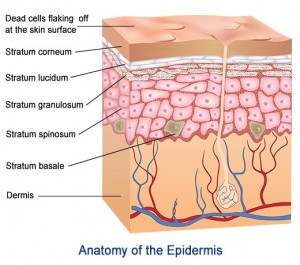The skin is the largest organ in the human body, and its complex physiology underlies both its critically important protective role to the organism, as well as its appearance (phenotype) to the outside world.
 The epidermis, the outermost layer of the skin, consists largely of cells called keratinocytes which provide barrier protection to moisture and heat loss, and pathogens. The lower layer of skin, the dermis, has a flexibility and tensile strength due to collagen and elastic proteins, and physical resilience due to their anchorage to the extracellular matrix (ECM), an important structural component found throughout the body.
The epidermis, the outermost layer of the skin, consists largely of cells called keratinocytes which provide barrier protection to moisture and heat loss, and pathogens. The lower layer of skin, the dermis, has a flexibility and tensile strength due to collagen and elastic proteins, and physical resilience due to their anchorage to the extracellular matrix (ECM), an important structural component found throughout the body.
The physiological and functional integrity of each of the components of the skin, and the maintenance of stable and healthy conditions (homeostasis) in the skin tissue, relies on biochemical pathways that enable the continuous and proper development, proliferation and differentiation of skin cells under specific conditions. MicroRNAs play essential regulatory functions in each of these states.





